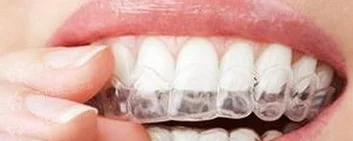9 things you need to know if you want to wear invisible braces

In traditional braces, small iron pieces called brackets are bonded to the teeth, and the orthodontic archwires are ligated to move the teeth to achieve the purpose of correction. But because there are many orthodontic devices on the teeth, it gives people the feeling of "iron mouth and steel teeth."
At the same time, if the oral hygiene is not well maintained, it may cause oral damage such as gum inflammation, tooth demineralization, and discoloration, which makes many patients, predominantly adult patients, afraid of "correction." As a result, bracketless invisible correction technology and orthotics came into being.
Invisible braces are based on the new 3D computer technology; a series of almost invisible transparent braces are tailored to complete the entire correction treatment. Whether it is due to crowded teeth, gaps, or teeth that have shifted after traditional treatment, you can definitely regain a bright smile.
Frequently Asked Questions About Invisible Braces
The main goal of orthodontics is to align the teeth and adjust the occlusion. So first of all, the reason most people wear braces is: their teeth are not good-looking. Whether your teeth are neat and beautiful will directly affect the value of your face. In addition, dental problems may also affect the shape of the face, especially the profile, such as protruding mouth, bulging sky, etc.
In recent years, invisible braces without brackets have become more and more popular. Users wear transparent braces that can be removed by themselves for correction, which is basically invisible from the appearance. More and more people are asking for invisible correction. The difference between invisible correction and traditional correction is obvious.
Generally, it is about 1-2 years, but the time required for treatment will increase or decrease depending on the age, severity, and response of teeth to treatment. As long as you cooperate with the doctor, follow up on time, maintain oral hygiene and protect the appliance from damage, the efficiency of treatment can be greatly improved!
There is no age limit for invisible correction. Of course, teenagers have fast metabolism and strong adaptability, and the time required for orthodontics is relatively short. But this does not mean that orthodontics is limited to minors. Adult patients can accept orthodontics as long as the tooth's own periodontal condition permits.
Generally speaking, for minor bony or dental bony problems, there is a chance to get good results through invisible correction; serious bony problems require combined orthodontics and orthognathic treatment. As for which one you are, you still need to go to the hospital for filming to make the final judgment.
Malocclusion of teeth not only affects facial appearance and beauty, but also affects health:
(1) Affect the normal performance of oral function: reduce the efficiency of teeth chewing, affect mouth pronunciation, and may even cause temporomandibular joint disorders, migraines and other problems.(2) Affect the health of periodontal tissues and oral hygiene: it may cause tartar accumulation, dental caries, gum periodontal problems.
(3) Affecting mental health: tooth deformities cause low self-esteem, unable to let go of laughter.
Therefore, orthodontics is to formulate a treatment plan from multiple angles such as the neatness of the teeth, the occlusal relationship, and the beauty of the face, so that you have healthy teeth and a bright and beautiful smile, ensuring that our oral cavity can maintain a long-term health., A stable state.
People who talk about old age have this misunderstanding: confuse orthodontics with periodontal disease. The loose and falling teeth of the elderly are mainly due to periodontitis! Periodontitis causes the alveolar bone to be absorbed, the root of the tooth is exposed, and the tooth loosens and falls out.
Orthodontics is to induce tooth movement through light correction force. It is a slow biological reconstruction process. One side of the moving tooth is absorbed by bone, and one side of the bone is renewed. Finally, the tooth moves to the normal position. The process is gradual. It is stable, and regular invisible orthodontics will not cause trauma to the teeth and periodontal tissues, so how can it "tooth loss"?
First of all, at the beginning of wearing braces and the first few days after each follow-up visit, you will feel sore and soft teeth, weak biting, and slight pain when brushing your teeth. These are all normal phenomena. In the past few days, the diet is mainly soft and semi-liquid, such as rotten noodles, rice porridge, egg custard and so on.
One of the biggest advantages of invisible orthodontics is that it can be removed at any time. When eating and drinking colored beverages, the braces need to be removed. After eating, clean the teeth and braces before wearing them. Food and beverages will not remain in the appliance, and oral cleaning is more timely and effective.
In this case, you can put on a pair of braces and contact the doctor in time to make up for the missing pair. Therefore, we suggest that the used braces can not be thrown away temporarily, in case of emergency.

All information and articles available on this site are for educational purposes only. The information given here should not be used without any expert advice for the diagnosis or treatment of any health related problem or disease. Always seek the advice of a qualified doctor for medical examination and treatment.
